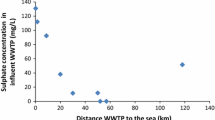Abstract
The sulphate-reducing bacteria Desulfovibrio desulfuricans have been identified in 25 different samples from diverse German and Austrian sulphur springs as well as in 42 samples of connate water from the Carboniferous of the Ruhr basin. From 33 of these samples, the bacteria were cultivated and tests were conducted to establish their tolerances to the salt content, pH and temperature. Further studies demonstrated a considerable tolerance for certain metal ions. The ecological conditions of Desulfovibrio desulfuricans are described and their importance in the “diagenesis” of connate water and the genesis of the sulphur springs is pointed out.
Similar content being viewed by others
Literatur
Baars, J. K.: Over sulfaatreductie door bacterien. Diss. Delft/Holland (1930), 164 S.
Bastin, E. S.: The problem of the natural reduction of sulphates. Bull. Am. Assoc. Petrol. Geologists 10, 1270–1299 (1926).
Behre jr., C. H., and R. K. Summerbell: Oxidation-reduction reactions between natural hydrocarbons and oil-filled waters. Science 79, 39–40 (1934).
Beijerinck, M. W.: Über Spirillum desulfuricans als Ursache von Sulfatreduction. Zentr. Bakteriol., Parasitenk. 11, 1, 1–9 (1895).
Carlé, W.: Rezente und fossile Mineral- und Thermalwässer im Oberrheintal- Graben und seiner weiteren Umgebung. Jahresber. u. Mitt. oberrh. geol. Ver., N.F. 40, 77–105 (1958).
—: Das neue Schwefel-Heilwasser von St. Peter-Ording. Heilbad und Kurort 14, 4–6 (1962).
Deevey, E. S., N. Nakai, and M. Stuiver: Fractionation of sulfur and carbon isotopes in a meromictic lake. Science 139, No 3553, 407–408 (1963).
Deutsche Forschungsgemeinschaft: Bericht über das Kolloquium „Schwefel-Isotopengeo-chemie“ in Bad Sooden-Allendorf vom 1. bis 2. Oktober 1964.
Dienemann, W., u. K. Fricke: Mineral- und Heilwässer, Peloide und Heilbäder in Niedersachsen und seinen Nachbargebieten. Veröffentl. Nieders. Inst. für Landesk., Universität Göttingen (zugl. Schriften Wirtschaftswiss. Niedersachsen A), Bd. 5, Abt. 5. Göttingen u. Hannover 1961.
Einsele, G., u. R. Mosebach: Zur Petrographie, Fossilerhaltung und Entstehung der Gesteine des Posidonienschiefers im Schwäbischen Jura. Neues Jahrb. Geol. u. Paläontol., Abhandl. 101, Nr. 3, 319–430 (1955).
Feely, H. W., and J. L. Kulp: Origin of gulf-coast salt-dome sulfur deposits. Bull. Amer. Assoc. Petrol. Geologists 41, 1802–1853 (1957).
Ginter, R. L.: Sulphate reduction in deep subsurface waters. Problems of Petroleum Geology Am. Ass. Petr. Geol. Tulsa, Oklahoma, 907–925 (1934).
Grupe, O.: Bitumenführende Horizonte im nordwestdeutschen Weißen Jura und ihre Bedeutung als Bildner schwefelwasserstoffhaltiger Grundwässer und Quellen. Geol. Jahrb. 53, 702–730 (1932).
Gunkel, W., and C. H. Oppenheimer: Experiments regarding the sulfide formation in Sediments of the Texas Gulf Coast. Symp. on Marine Microbiology, chapt. 63, p. 674–684 (Ed. C. H. Oppenheimer). Springfield (Ill.): Ch. C. Thomas 1963.
Harrison, A. G., and H. G. Thode: Mechanism of the bacterial reduction of sulphate from isotope fractionation studies. Trans. Faraday Soc. 4, 84–92 (1958).
Jensen, M. L.: Biogeochemistry of sulfur isotopes. Proc. Nat. Science Foundation Symp. April 12–14, 1962. New Haven, Conn.: Yale University 1962.
Kaplan, I. R., K. O. Emery, and S. C. Rittenberg: The distribution and isotopic abundance of sulphur in recent marine sediments off southern California. Geochim. et Cosmochim. Acta 27, 297–331 (1963).
Kimata, M., H. Kadota, Y. Hata, and H. Miyoshi: Growth of sulfate reducing bacteria in relation to the oxidation reduction potential of culture media. Records Oceanogr. Works Japan, Special No. 3, 167–174 (1959).
Konstantinov, M. M.: On the nature of sulfur of mineral waters and hydrothermal deposits. Geokhimiya 11 (Brief Communications), 1145–1147 (1961).
Kuznetsov, S. I., M. V. Ivanov, and N. N. Lyalikova: Introduction to geological microbiology. Internat. Ser. on Earth Sciences 252 p. New York-San Francisco-Toronto-London: McGraw-Hill Book Co., Inc., 1963.
La Riviére, J. W. M.: The sulfur cycle and some of its geochemical implications. Geol. Rundschau (1965, im Druck).
Meyer, L.: Chemische Untersuchungen der Thermen zu Landeck in der Grafschaft Glatz. J. prakt. Chem. 91, 5–6 (1864).
Murray, J., and R. Irvin: On the chemical changes which take place in the composition of sea water associated with blue mud on the floor of the ocean. Trans. Roy. Soc. Edinburgh 37, 481–508 (1895).
Puchelt, H.: Zur Geochemie des Grubenwassers im Ruhrgebiet. Z. deut. geol. Ges. 116, Teil 1, 167–203 (1964).
- Geochemie der Grubenwässer im Ruhrkarbon und ihre Bedeutung für die westfälischen Ganglagerstätten. In Vorbereitung (1966).
-, u. H. Nielsen: Schwefelisotopen-Untersuchungen an Grubenwässern des Ruhrgebietes. Bergbau Arch., im Druck (1966a).
- -, Schwefelisotopenuntersuchungen an Schwefelquellen Deutschlands und Österreichs. Beitr. Min. Petr. im Druck (1966 b).
Quentin, K.-E.: Die Heilquellen von Bad Wiessee. Heilbad und Kurort 1, 1–11 (1958).
—: Die Schwefelquelle des Nordseeheilbades St. Peter-Ording. Heilbad und Kurort 2, 23–24 (1960).
Scheminzky, F., u. H. Pitschmann: Die Biologie der Heilquellen und ihre Bedeutung für die Bäderheilkunde. In: Amtl. Österr. Bäderbuch, 1. Abschn., S. 23–34. Wien: Frick 1959.
Wallhäusser, K. H.: Mikrobiologische Untersuchungen über Flutwässer bei der Erdölgewinnung. Erdöl u. Kohle 18, 357–360 (1965).
-, u. E. Diekmann: Vorkommen und Bekämpfung von Desulfovibrio desulfuricans in Untertagegasspeichern. Erdöl u. Kohle 19 (im Druck).
Zobell, C. E.: Studies on the bacterial flora of marine bottom sediments. J. Sediment. Petrol. 8, 10–18 (1938).
—: Ecology of sulfate reducing bacteria. Producers Monthly 22, 12–29 (1958).
—: Organic geochemistry of sulfur. Chapt. 13 in “Organic Geochemistry”, Internat. Ser. of Monographs on Earth Sciences, vol. 16, p. 543–578 (Symp. Publ. Division (Edit. Irving A. Breger). Oxford-London-New York-Paris: Pergamon Press 1963.
Author information
Authors and Affiliations
Additional information
Wir danken den Herren Markscheidern der erwähnten Gruben und den zuständigen Herren der Bäderverwaltungen für Unterstützung bei der Probenahme, Herrn Universitäts-Professor Dr. F. Scheminzky, Innsbruck, für die Überlassung von Unterlagen über Geologie und Chemismus der österreichischen Schwefelquellen sowie Herrn Professor Dr. W. von Engelhardt, dem Direktor des Mineralogisch-Petrographischen Instituts der Universität Tübingen, für förderndes Interesse an dieser Arbeit. Die Entnahme der Proben erfolgte im Rahmen der von der Deutschen Forschungsgemeinschaft unterstützten Schwefelisotopenuntersuchungen an Schwefelquellen Deutschlands und Österreichs.
Rights and permissions
About this article
Cite this article
Wallhäusser, K.H., Puchelt, H. Sulfatreduzierende Bakterien in Schwefel- und Grulbenwässern Deutschlands und Österreichs. Contr. Mineral. and Petrol. 13, 12–30 (1966). https://doi.org/10.1007/BF00518124
Received:
Issue Date:
DOI: https://doi.org/10.1007/BF00518124




